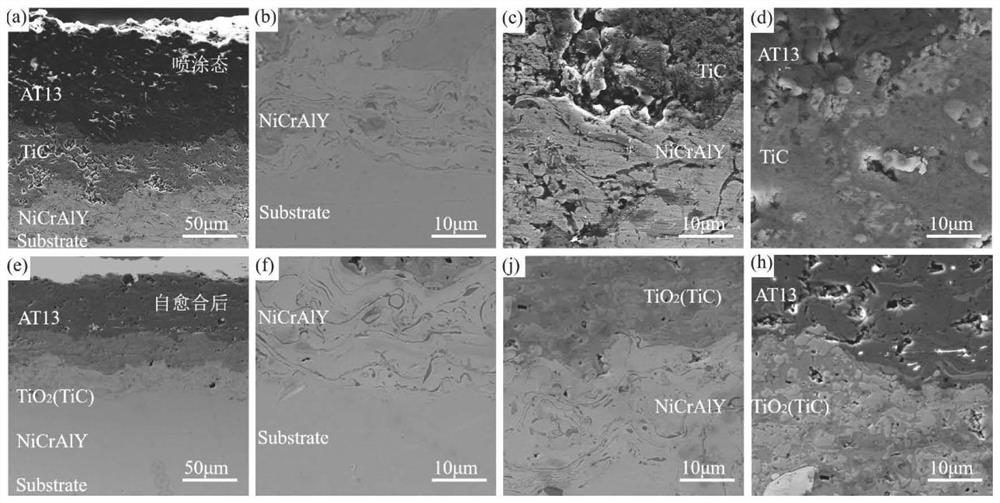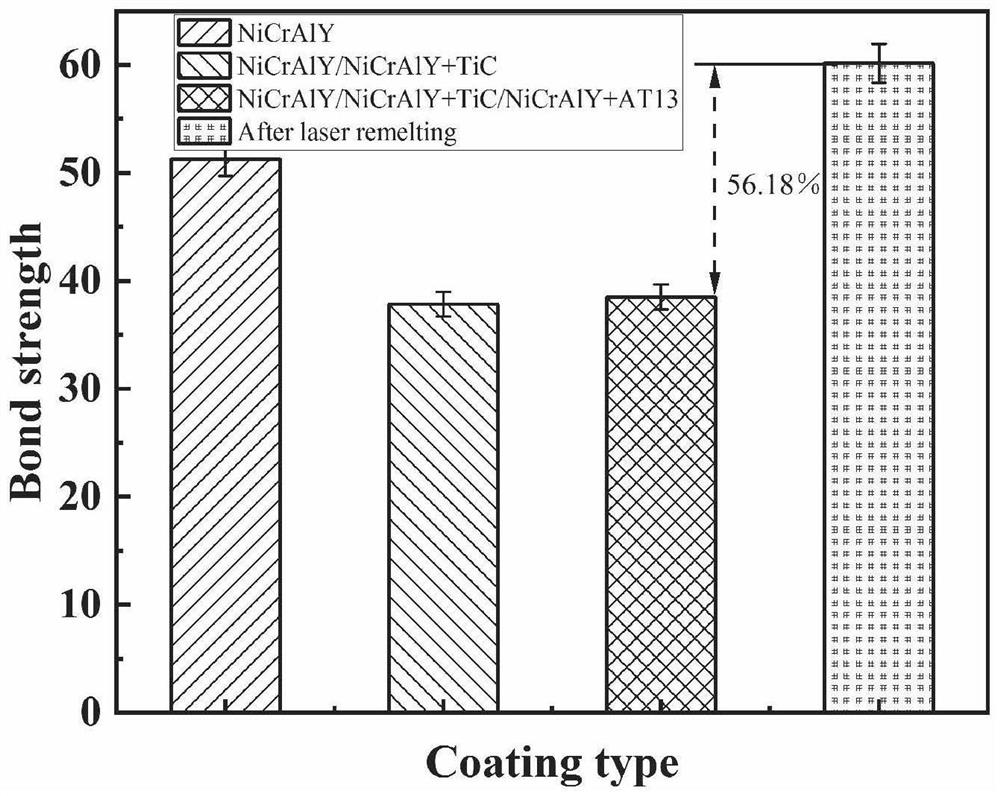Self-healing coating for improving interlayer bonding energy and preparation method thereof
A self-healing and binding energy technology, used in coatings, metal material coating processes, melt spraying, etc., can solve the problems of high porosity, unevenness, high energy consumption, and improve binding energy and surface morphology. , the effect of low porosity
- Summary
- Abstract
- Description
- Claims
- Application Information
AI Technical Summary
Problems solved by technology
Method used
Image
Examples
Embodiment 1
[0051] (1) Surface mechanical polishing: The hot-rolled austenitic stainless steel samples are polished with different grain sizes (80#~1200#) sandpaper until there are no obvious scratches visible to the naked eye, and then cleaned with acetone for 5~20min in ultrasonic waves to remove oil. , ultrasonic cleaning with absolute ethanol for 5~20min, remove stains, and finally put it in a drying oven at 80°C for drying for 20~40min; (among which, 321 austenitic stainless steel is a rolled sheet, and the mass fraction of its chemical composition is C 0.04%, Si 0.38 %, Mn 1.08%, Cr 17.02%, Ni 9.06%, N 0.05%, P 0.03%, Ti 0.22%, the rest is Fe. The mechanical properties of 321 stainless steel at room temperature are: tensile strength (σb) 667MPa, yield strength (σ0.2) 245MPa, elongation 56.5%, hardness 175HV.) The chromium hardness of the base metal should be less than 40, and if the hardness is too high, it is not conducive to the bonding between the coating and the base surface duri...
Embodiment 2
[0059](1) Surface mechanical polishing: The hot-rolled austenitic stainless steel samples are polished with different grain sizes (80#~1200#) sandpaper until there are no obvious scratches visible to the naked eye, and then cleaned with acetone for 5~20min in ultrasonic waves to remove oil. , ultrasonic cleaning with absolute ethanol for 5~20min, remove stains, and finally put it in a drying oven at 80°C for drying for 20~40min; (among which, 321 austenitic stainless steel is a rolled sheet, and the mass fraction of its chemical composition is C 0.04%, Si 0.38 %, Mn 1.08%, Cr 17.02%, Ni 9.06%, N 0.05%, P 0.03%, Ti 0.22%, the rest is Fe. The mechanical properties of 321 stainless steel at room temperature are: tensile strength (σb) 667MPa, yield strength (σ0.2) 245MPa, elongation 56.5%, hardness 175HV.) The chromium hardness of the base metal should be less than 40, and if the hardness is too high, it is not conducive to the bonding between the coating and the base surface durin...
Embodiment 3
[0067] (1) Surface mechanical polishing: The hot-rolled austenitic stainless steel samples are polished with different grain sizes (80#~1200#) sandpaper until there are no obvious scratches visible to the naked eye, and then cleaned with acetone for 5~20min in ultrasonic waves to remove oil. , ultrasonic cleaning with absolute ethanol for 5~20min, remove stains, and finally put it in a drying oven at 80°C for drying for 20~40min; (among which, 321 austenitic stainless steel is a rolled sheet, and the mass fraction of its chemical composition is C 0.04%, Si 0.38 %, Mn 1.08%, Cr 17.02%, Ni 9.06%, N 0.05%, P 0.03%, Ti 0.22%, the rest is Fe. The mechanical properties of 321 stainless steel at room temperature are: tensile strength (σb) 667MPa, yield strength (σ0.2) 245MPa, elongation 56.5%, hardness 175HV.) The chromium hardness of the base metal should be less than 40, and if the hardness is too high, it is not conducive to the bonding between the coating and the base surface duri...
PUM
| Property | Measurement | Unit |
|---|---|---|
| Tensile strength | aaaaa | aaaaa |
| Yield strength | aaaaa | aaaaa |
| Particle size | aaaaa | aaaaa |
Abstract
Description
Claims
Application Information
 Login to View More
Login to View More - R&D
- Intellectual Property
- Life Sciences
- Materials
- Tech Scout
- Unparalleled Data Quality
- Higher Quality Content
- 60% Fewer Hallucinations
Browse by: Latest US Patents, China's latest patents, Technical Efficacy Thesaurus, Application Domain, Technology Topic, Popular Technical Reports.
© 2025 PatSnap. All rights reserved.Legal|Privacy policy|Modern Slavery Act Transparency Statement|Sitemap|About US| Contact US: help@patsnap.com



